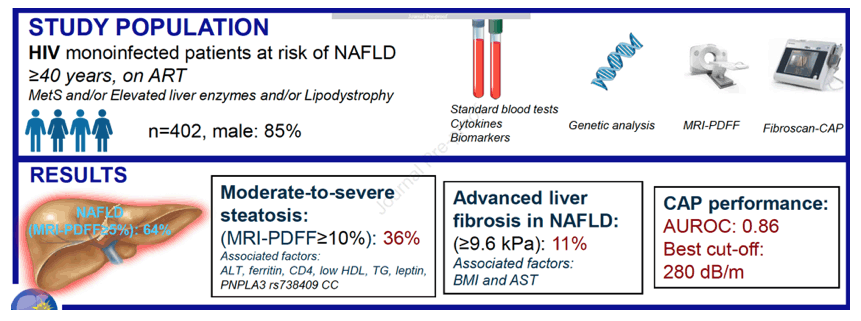| |
Screening HIV patients at risk for NAFLD using
MRI-PDFF and transient elastography: a European
multicenter prospective study - patients with MetS
had the highest prevalence of NAFLD (71%)
|
| |
| |
Download the PDF
April 15, 2022
Clinical Gastroenterology and Hepatology - Maud Lemoine, Lambert Assoumou, Pierre-Marie Girard, Marc Antoine Valantin, Christine Katlama, Stephane De Wit, Pauline Campa, Hayette Rougier, Jean-Luc Meynard, Coca Necsoi, Anja D. Huefner, Jan Van Luzen, Julian Schulze zur Wiesch, Jean-Philippe Bastard, Soraya Fellahi, Stefan Mauss, Metodi V. Stankov, Axel Baumgarten, Gerrit Post, Lawrence Serfaty, Vlad Ratziu, Yves Menu, Jerome Schlue, Pierre Bedossa, Jacqueline Capeau, Dominique Costagliola, Georg Behrens, Patrick Ingiliz, on behalf of the ANRS-ECHAM group

so why are older PLWH NOT being screened fr fatty liver disease or NAFLD ??? While a spectrum of hepatic complications is associated with NAFLD such as hepatocellular carcinoma and cirrhosis [4], cardiovascular disease remains the leading cause of death in NAFLD
"Overall 257/402 (64%) had NAFLD (MRI-PDFF≥5%). Among them, 11.3% had a liver stiffness ≥9.6 kPa, suggestive of Advanced fibrosis".
"CAP had good performance for the diagnosis of moderate-to-severe liver steatosis"
"patients with MetS had the highest prevalence of NAFLD (71%)....36% with abnormal liver enzymes without metabolic syndrome had CAP score of median 260"
"our study confirms that in aging PLWH with metabolic disorders (MetS and/or lipodystrophy) and/or abnormal liver enzymes, the proportion of NAFLD (64%) and advanced fibrosis (11%) is high. One third had moderate-to-severe liver steatosis (MRI-PDFF≥10%), which could be easily identified using CAP (best cut-off 280 dB/m)."
"PLWH with high BMI and AST level should be of particular attention for liver fibrosis screening and monitoring. In the absence of validated drugs for the treatment of NAFLD in HIV-monoinfected, our data confirms that the control of metabolic disorders in this population is critical"
In this multicenter European study, we conducted a comprehensive hepatic and metabolic assessment
of HIV-monoinfected patients at risk of NAFLD (i.e aged over 40 years, exposed to cART for more than 5 years with a MetS or persistently elevated liver enzymes or clinical lipodystrophy). We selected this population, as now recommended by the EACS guidelines17, in order to describe the burden of NAFLD in the potentially most affected PLWH who are most likely to be referred for liver assessment in clinical practice.
People living with HIV (PLWH) are considered at high risk of NAFLD due to an increased prevalence of traditional metabolic risk factors and aging5,6. Life expectancy of PLWH has, indeed, greatly improved and, at present, in Western countries more than half of PLWH are more than 50 years with a high prevalence of age-related comorbidities6. Globally, the metabolic syndrome (MetS) affects 17% to 31% of PLWH11 and, as a consequence, NAFLD in PLWH has now become a growing concern7. A systematic review and meta-analysis estimated the overall prevalence of NAFLD in monoinfected-PLWH as 35% (95% confidence interval (CI) 29-42) in the Western world8, but underlined the limited number of studies, often based on heterogeneous diagnostic criteria; In contrast to the non-HIV population, data on NAFLD in PLWH is scarce and heterogeneous9-16 with liver histology being hardly performed in this population. This gap hampers the development of international strategies for the diagnosis and management of NAFLD in PLWH6
Among the 402 study patients, 257 had a MRI-PDFF ≥5% and 145 MRI-PDFF ≥10% giving a prevalence of steatosis at any degree of 64% (95%CI: 59-69) and of moderate-to-severe steatosis of 36% (95%CI: 31-41). The proportion of steatosis (MRI PDFF≥10%) was the highest in patients with MetS (43%) and abnormal liver enzymes (44%) and the lowest in patients with isolated lipodystrophy (14%), p<0.0001 (Table 1).
We found a high proportion of NAFLD (64%) including 36% presenting moderate-to-severe steatosis and, using liver stiffness measurement, 11% had advanced fibrosis including 6% with cirrhosis.
Not surprisingly, patients with MetS had the highest prevalence of NAFLD (71%) whilst patients with isolated lipodystrophy had a lower prevalence (43%) and a markedly better metabolic profile and insulin sensitivity suggesting that the dysmetabolic profile with insulin resistance observed in subjects with283
MetS, plays a key role in the development of NAFLD, as observed in the general population1
-----------------------------------------------
Abstract
Background & aims: Non-alcoholic fatty liver disease (NAFLD) is a growing concern in the aging HIV population. Screening for NAFLD is recommended in patients with metabolic risk factors or unexplained transaminitis. This study aimed to prospectively assess the prevalence and associated factors of liver steatosis and advanced fibrosis (AF) in HIV-monoinfected patients at risk of NAFLD.
Methods: We conducted a multicenter study in HIV-monoinfected patients, non-excessive drinkers with metabolic syndrome (MetS) and/or persistently elevated liver enzymes and/or clinical lipodystrophy. All participants had MRI-PDFF, Fibroscan®//CAP and cytokine and genetic analysis.
Results: From March 2014 to November 2015, we enrolled 442 participants and analysed 402: male (85%), median age 55 years (IQR 50-61), BMI 27.0 kg/m2 (23.6-28.7), MetS (67%), CD4 cells count 630/mm3 (510-832).
Overall 257/402 (64%) had NAFLD (MRI-PDFF≥5%). Among them, 11.3% had a liver stiffness ≥9.6 kPa, suggestive of AF.
Multivariable analysis identified seven factors of steatosis: high CD4-cell count (OR:4.04 (95%CI: 1.92-8.51)), high leptin level (OR:2.12 (1.14-3.93)), non-CC PNPLA3s738409 genetic polymorphism (OR:1.92 (1.11-3.33)), low HDL (OR:1.83 (1.03-3.27)), high triglycerides (OR:1.48 (1.18-1.84)), elevated ALT (OR:1.23 (1.16-1.31)) and hyper ferritinemia (OR:1.05 (1.03-1.07).
Two factors were associated with AF: high BMI (OR:1.23 (1.07-1.42), p=0.005, and elevated AST (OR:1.03 (1.01-1.05), p=0.001).Using MRI-PDFF as a reference, CAP (best cut-off 280 dB/m) had good accuracy (0.86 (0.82-0.90) for the diagnosis of moderate-to-severe steatosis.
Conclusions: In a large cohort of HIV-moninfected patients at risk of NAFLD, steatosis is present in two third of cases and around 10% have AF. The CAP technique is accurate for screening steatosis in this population.
|
|
| |
| |
|
|
|